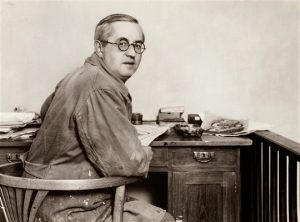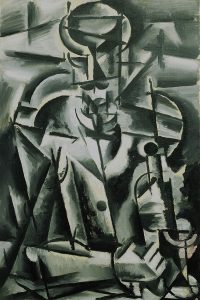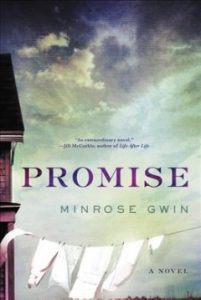And a very happy Free For All Birthday to Czech poet, author, and painter Josef Čapek!

Čapek was born on this day in Hronov, Bohemia (now the Czech Republic) in 1887. We was originally trained as a painter, and his works were representative of the Cubist school, with lots of geometric shapes and lack of depth perception (you can see an example of his work below this paragraph). He also wrote plays and essays, especially on the subject of art, and the worth of art produced by those who were considered “unartistic,” especially children and natives in imperial countries (whose work was considered “primitive”). In addition, he collaborated with his brother Karel on a number of plays and short stories. One of those plays, which we’ll discuss in just a moment, brought the word “robot” into modern parlance. Because of Čapek criticism of national socialism and Hitler specifically, he was arrested following the German invasion of Czechoslovakia in 1939 and was sent to the Bergen-Belsen concentration camp. He wrote He wrote Poems from a Concentration Camp there before his death, which was assumed to be in 1945. Though his wife and friends searched after the war, his remains were never recovered.

It was the Čapek brothers’ 1920 play R.U.R. which popularized the international word “robot”. For years, it was assumed that Karel Čapek had developed the word, he wrote a short letter in reference to an article in the Oxford English Dictionary etymology in which he named Josef as the word’s actual inventor. In a a later article published in 1933, Karel also explained that his idea was to call the creatures laboři (after the Latin word for labor). It was Josef, he said, who suggested roboti (robots in English), from the Czech word robota, which means, literally, “serf labor”, or “hard work”.
So today, let’s celebrate the courage, convictions, and creativity of Josef Čapek–and what better way that enjoying the remarkable books available to you at the Library (we don’t have robots, but we have books!). Here are some of the great ones that shuffled onto our shelves this week:

 Picasso and the Painting that Shocked the World: Since we’re celebrating a Cubist artist today, Miles J. Unger’s book on the origins of Picasso’s Les Demoiselles d’Avignon seemed like an ideal selection today. Picasso arrived in Paris in 1900, living and working in a squalid tenement known as the Bateau Lavoir, in the heart of picturesque Montmartre. Slowly, painstakingly, he built his reputation, and amassed a wealth of avant-garde comrades and friends whose collective artistic influence is being felt to this day. In 1906 Picasso began his early masterpiece known as Les Demoiselles d’Avignon. Inspired by the groundbreaking painting of Paul Cézanne, as well as African and tribal sculpture, Picasso’s work was seen as a defining image of modernity. The painting proved so shocking that even his friends assumed he’d gone mad. Only his colleague George Braque understood what Picasso was trying to do. Over the next few years they teamed up to create Cubism, the most revolutionary and influential movement in twentieth-century art. Unger’s book looks at the individuals, the interactions, and the influences that helped Picasso create this seminal work in a well-research and wonderfully readable book that earned a starred review from Publisher’s Weekly, who called it “Riveting. . . . This engrossing book chronicles with precision and enthusiasm a painting with lasting impact in today’s art world.”
Picasso and the Painting that Shocked the World: Since we’re celebrating a Cubist artist today, Miles J. Unger’s book on the origins of Picasso’s Les Demoiselles d’Avignon seemed like an ideal selection today. Picasso arrived in Paris in 1900, living and working in a squalid tenement known as the Bateau Lavoir, in the heart of picturesque Montmartre. Slowly, painstakingly, he built his reputation, and amassed a wealth of avant-garde comrades and friends whose collective artistic influence is being felt to this day. In 1906 Picasso began his early masterpiece known as Les Demoiselles d’Avignon. Inspired by the groundbreaking painting of Paul Cézanne, as well as African and tribal sculpture, Picasso’s work was seen as a defining image of modernity. The painting proved so shocking that even his friends assumed he’d gone mad. Only his colleague George Braque understood what Picasso was trying to do. Over the next few years they teamed up to create Cubism, the most revolutionary and influential movement in twentieth-century art. Unger’s book looks at the individuals, the interactions, and the influences that helped Picasso create this seminal work in a well-research and wonderfully readable book that earned a starred review from Publisher’s Weekly, who called it “Riveting. . . . This engrossing book chronicles with precision and enthusiasm a painting with lasting impact in today’s art world.”
 Broad Band: The Untold Story of the Women Who Made the Internet: Oh hey, and speaking of technology, how about Claire L. Evan’s book that re-frames the history of modern computer technology as female; from Ada Lovelace, who wrote the first computer program in the Victorian Age, to the cyberpunk Web designers of the 1990s, female visionaries have always been at the vanguard of technology and innovation. In fact, Evans points out, women turn up at the very beginning of every important wave in technology. They may have been hidden in plain sight, their inventions and contributions touching our lives in ways we don’t even realize, but they have always been part of the story. Seek inspiration from Grace Hopper, the tenacious mathematician who democratized computing by leading the charge for machine-independent programming languages after World War II. Meet Elizabeth “Jake” Feinler, the one-woman Google who kept the earliest version of the Internet online, and Stacy Horn, who ran one of the first-ever social networks on a shoestring out of her New York City apartment in the 1980s. Join the ranks of the pioneers who defied social convention to become database poets, information-wranglers, hypertext dreamers, and glass ceiling-shattering dot com-era entrepreneurs. This inspiring history shines a light on some of the bright minds that have as yet gone unrecognized in the history of computer sciences that The Wall Street Journal called “a celebration of the women whose minds gave birth to the motherboard and its brethren…. an engaging series of biographical essays on lesser known mathematicians, innovators and cyberpunks.”
Broad Band: The Untold Story of the Women Who Made the Internet: Oh hey, and speaking of technology, how about Claire L. Evan’s book that re-frames the history of modern computer technology as female; from Ada Lovelace, who wrote the first computer program in the Victorian Age, to the cyberpunk Web designers of the 1990s, female visionaries have always been at the vanguard of technology and innovation. In fact, Evans points out, women turn up at the very beginning of every important wave in technology. They may have been hidden in plain sight, their inventions and contributions touching our lives in ways we don’t even realize, but they have always been part of the story. Seek inspiration from Grace Hopper, the tenacious mathematician who democratized computing by leading the charge for machine-independent programming languages after World War II. Meet Elizabeth “Jake” Feinler, the one-woman Google who kept the earliest version of the Internet online, and Stacy Horn, who ran one of the first-ever social networks on a shoestring out of her New York City apartment in the 1980s. Join the ranks of the pioneers who defied social convention to become database poets, information-wranglers, hypertext dreamers, and glass ceiling-shattering dot com-era entrepreneurs. This inspiring history shines a light on some of the bright minds that have as yet gone unrecognized in the history of computer sciences that The Wall Street Journal called “a celebration of the women whose minds gave birth to the motherboard and its brethren…. an engaging series of biographical essays on lesser known mathematicians, innovators and cyberpunks.”
 The Coincidence Makers: Israeli author Yoav Blum’s debut novel is now available in English, and is an idea blend of genres for anyone looking for something completely novel. What if the drink you just spilled, the train you just missed, or the lottery ticket you just found was not just a random occurrence? What if it’s all part of a bigger plan? What if there’s no such thing as a chance encounter? What if there are people we don’t know determining our destiny? And what if they are even planning the fate of the world? Enter the Coincidence Makers―Guy, Emily, and Eric―three seemingly ordinary people who work for a secret organization devoted to creating and carrying out coincidences. What the rest of the world sees as random occurrences, are, in fact, carefully orchestrated events designed to spark significant changes in the lives of their targets―scientists on the brink of breakthroughs, struggling artists starved for inspiration, future soulmates? When an assignment of the highest level is slipped under Guy’s door one night, he knows it will be the most difficult and dangerous coincidence he’s ever had to fulfill. But not even a coincidence maker can see how this assignment is about to change all their lives and teach them the true nature of fate, free will, and the real meaning of love. This quirky and heartfelt story earned a starred review from Booklist, who said in its review, “Artfully blending elements of thriller, romance, and fantasy in a beautiful prose, Blum’s novel is a flight of imagination that will echo in readers’ minds long after the last pages have been turned.”
The Coincidence Makers: Israeli author Yoav Blum’s debut novel is now available in English, and is an idea blend of genres for anyone looking for something completely novel. What if the drink you just spilled, the train you just missed, or the lottery ticket you just found was not just a random occurrence? What if it’s all part of a bigger plan? What if there’s no such thing as a chance encounter? What if there are people we don’t know determining our destiny? And what if they are even planning the fate of the world? Enter the Coincidence Makers―Guy, Emily, and Eric―three seemingly ordinary people who work for a secret organization devoted to creating and carrying out coincidences. What the rest of the world sees as random occurrences, are, in fact, carefully orchestrated events designed to spark significant changes in the lives of their targets―scientists on the brink of breakthroughs, struggling artists starved for inspiration, future soulmates? When an assignment of the highest level is slipped under Guy’s door one night, he knows it will be the most difficult and dangerous coincidence he’s ever had to fulfill. But not even a coincidence maker can see how this assignment is about to change all their lives and teach them the true nature of fate, free will, and the real meaning of love. This quirky and heartfelt story earned a starred review from Booklist, who said in its review, “Artfully blending elements of thriller, romance, and fantasy in a beautiful prose, Blum’s novel is a flight of imagination that will echo in readers’ minds long after the last pages have been turned.”
 Promise: Rooted in historical events, Minrose Gwin’s journey through the heart of the Depression-era South is evocative, insightful, and probing, offering fans of any time period plenty to savor. A few minutes after 9 p.m. on Palm Sunday, April 5, 1936, a tornado struck the thriving cotton-mill town of Tupelo, Mississippi, killing more than 200 people. This figure does not include the town’s Black citizens, one-third of Tupelo’s population, who were not included in the official casualty figures. When the tornado hits, Dovey, a local laundress, is flung into a nearby lake. Bruised and nearly drowned, she makes her way across Tupelo to find her small family. Slowly navigating the broken streets of Tupelo, Dovey stops at the house of the despised McNabb family. Inside, she discovers that the tornado has spared no one, including Jo, the McNabbs’ dutiful teenage daughter, who has suffered a terrible head wound. When Jo later discovers a baby in the wreckage, she is certain that she’s found her baby brother, Tommy, and vows to protect him. During the harrowing hours and days of the chaos that follows, Jo and Dovey will struggle to navigate a landscape of disaster and to battle both the demons and the history that link and haunt them. Library Journal wrote a beautiful review of this book, which it called an “atmospheric whirlwind of a book. A memorable, dreamlike narrative…that vividly conveys what it was like to survive the fourth most deadly tornado in U.S. history; it also brings to light the vast disparity in the care and treatment of white vs. black residents.”
Promise: Rooted in historical events, Minrose Gwin’s journey through the heart of the Depression-era South is evocative, insightful, and probing, offering fans of any time period plenty to savor. A few minutes after 9 p.m. on Palm Sunday, April 5, 1936, a tornado struck the thriving cotton-mill town of Tupelo, Mississippi, killing more than 200 people. This figure does not include the town’s Black citizens, one-third of Tupelo’s population, who were not included in the official casualty figures. When the tornado hits, Dovey, a local laundress, is flung into a nearby lake. Bruised and nearly drowned, she makes her way across Tupelo to find her small family. Slowly navigating the broken streets of Tupelo, Dovey stops at the house of the despised McNabb family. Inside, she discovers that the tornado has spared no one, including Jo, the McNabbs’ dutiful teenage daughter, who has suffered a terrible head wound. When Jo later discovers a baby in the wreckage, she is certain that she’s found her baby brother, Tommy, and vows to protect him. During the harrowing hours and days of the chaos that follows, Jo and Dovey will struggle to navigate a landscape of disaster and to battle both the demons and the history that link and haunt them. Library Journal wrote a beautiful review of this book, which it called an “atmospheric whirlwind of a book. A memorable, dreamlike narrative…that vividly conveys what it was like to survive the fourth most deadly tornado in U.S. history; it also brings to light the vast disparity in the care and treatment of white vs. black residents.”
 The Affliction: Beth Gutcheon’s second novel featuring Maggie Detweiler and Hope Babbin has all the dark humor and dastardly deeds that have made this duo a fan favorite. Since retiring as head of a famous New York City private school, Maggie Detweiler has been keeping busy. Most recently, she’s served as the chair of a team to evaluate the faltering Rye Manor School for girls, and determining what future (if any) the school might have. With so much on the line for so many, tensions on campus are at an excruciating pitch, and no one seems more keen for all to go well than Florence Meagher, a star teacher who is loved and respected in spite of her affliction—that she can never stop talking. Florence is one of those dedicated teachers for whom the school is her life, and yet the next morning, when Maggie arrives to observe her teaching, Florence is missing. Florence’s husband, Ray, an auxiliary policeman in the village, seems more annoyed than alarmed at her disappearance. But Florence’s sister is distraught. There have been tensions in the marriage, and at their last visit, Florence had warned, “If anything happens to me, don’t assume it’s an accident.” Two days later, Florence’s body is found in the campus swimming pool. When she is asked to stay and coach the new head of the Rye Manor School, Maggie determines to get to the bottom of what happened to Florence. She’s joined by her friend Hope, who has been desperate for a reason to ditch her local bookclub, anyways. There are plenty of secrets buried in this idyllic small town, and Hope and Maggie certainly have their work cut out for them if they are to get to the bottom of all the nefarious work that’s afoot, including Florence’s silencing. Booklist loved this follow-up mystery, noting, “Humor and suspense in equal measure make for a delightful read in this second outing…for the well-heeled duo of Maggie Detweiler and Hope Babbin.”
The Affliction: Beth Gutcheon’s second novel featuring Maggie Detweiler and Hope Babbin has all the dark humor and dastardly deeds that have made this duo a fan favorite. Since retiring as head of a famous New York City private school, Maggie Detweiler has been keeping busy. Most recently, she’s served as the chair of a team to evaluate the faltering Rye Manor School for girls, and determining what future (if any) the school might have. With so much on the line for so many, tensions on campus are at an excruciating pitch, and no one seems more keen for all to go well than Florence Meagher, a star teacher who is loved and respected in spite of her affliction—that she can never stop talking. Florence is one of those dedicated teachers for whom the school is her life, and yet the next morning, when Maggie arrives to observe her teaching, Florence is missing. Florence’s husband, Ray, an auxiliary policeman in the village, seems more annoyed than alarmed at her disappearance. But Florence’s sister is distraught. There have been tensions in the marriage, and at their last visit, Florence had warned, “If anything happens to me, don’t assume it’s an accident.” Two days later, Florence’s body is found in the campus swimming pool. When she is asked to stay and coach the new head of the Rye Manor School, Maggie determines to get to the bottom of what happened to Florence. She’s joined by her friend Hope, who has been desperate for a reason to ditch her local bookclub, anyways. There are plenty of secrets buried in this idyllic small town, and Hope and Maggie certainly have their work cut out for them if they are to get to the bottom of all the nefarious work that’s afoot, including Florence’s silencing. Booklist loved this follow-up mystery, noting, “Humor and suspense in equal measure make for a delightful read in this second outing…for the well-heeled duo of Maggie Detweiler and Hope Babbin.”
Until next week, beloved patrons–happy reading!
